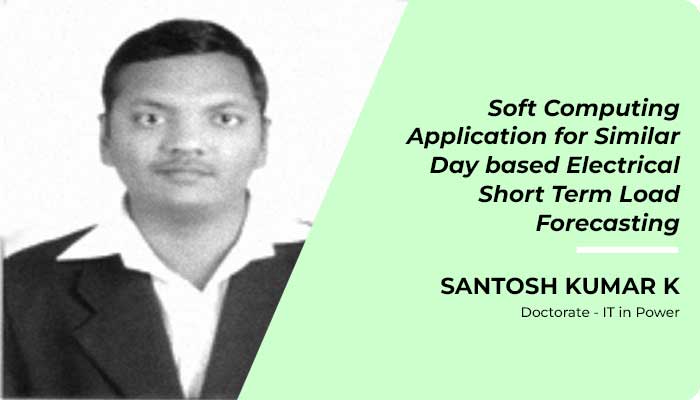Santosh Kumar Kukkadapu, supervised by Dr. Amit Jain (former faculty) received his doctorate in IT in Power (ITP). Here’s a summary of his research work on Soft Computing Application for Similar Day based Electrical Short Term Load Forecasting:
Electrical load forecasting is a prime element for power system planning, scheduling, economic
dispatch, unit commitment, maintenance, and electricity market. In practice, the electrical load is
having nonlinear behavior and electrical load demand depends upon various factors like the type
of day (day of the week etc.), weather variables like temperature, humidity, and the load on the
previous day etc. Electrical load forecasting can become more accurate by considering these
dominant factors.
Soft computing techniques have been successfully incorporated into a lot of scientific and
engineering problems during recent years. Soft computing methods are capable of dealing with
nonlinearity and these techniques are suitable candidates for electrical load forecasting problems.
In this thesis work, soft computing techniques like fuzzy logic and bio-inspired computation
techniques are chosen for similar day based electrical short term load forecasting. The fuzzy
logic is able to model uncertain and ambiguous data. The fuzzy logic system gives better forms
of rule expressions, reasoning logic like human thought.
This work presents fuzzy logic based Short Term Load Forecasting (STLF) by selecting similar
days, which are found from previous data by using Mahalanobis distance norm. The fuzzy logic
is chosen in the correction of similar days of the forecast day. The average of the corrected
hourly loads of the similar days achieved through the Mahalanobis distance norm of the forecast
day is then considered as the hourly load of the forecast day. The parameter limits of fuzzy
membership functions are determined and optimized through different optimization techniques
like Heuristic Approach, Particle Swarm Optimization (PSO), New Particle Swarm Optimization
(NPSO) and Evolutionary Particle Swarm Optimization (EPSO). In the first approach, Fuzzy
membership parameter values are tuned in a heuristic way. Another approach for the
optimization of fuzzy parameter values is to use PSO. It simulates the bird flocking behavior
where each particle fitness value can be evaluated in a search space by using the fitness function.
The particle’s direction of flying can be decided by its velocity and position. PSO function
updates the latest particle position by using an optimization equation based on the global best of
the previous iteration provided that it is better than the previous one.
NPSO technique is also attempted for the optimization of fuzzy parameter values. Each particle
tries to leave its previous worst position and the previous worst position of its group. NPSO
function modifies the latest particle position using the optimization equations based on the global
worst of the previous iteration provided that it is better than the previous one. The inclusion of
the evolution process in PSO is providing the Evolutionary Particle Swarm Optimization
(EPSO). EPSO has the properties of Replication, Mutation, Reproduction, Evaluation and
Selection. In this thesis, EPSO is also used for the optimization of fuzzy parameter values.
These optimized fuzzy parameter values are incorporating in Fuzzy Inference System (FIS) and
used for forecasting the load of forecast month.
It is difficult to forecast a load of anomalous days like holidays, religious days and special days
because their load profile is different when compared to normal days. Load forecasting for
anomalous days is also a challenging job because of small number of data availability compared
to the availability of data for normal weekdays and weekends. Hence, various methodologies are
developed for anomalous day load forecasting and presented in the present research work.
The short term load forecasting algorithms are developed for each optimization technique and
also forecasting methodologies for various case studies of anomalous day load forecasting and
these are tested by doing simulation studies on real-time data and results obtained are found
good, which have been presented in this thesis.
December 2023

